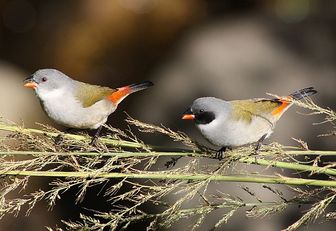Swee Waxbill
It breeds in Angola, Benin, The Democratic Republic of the Congo, Eritrea, Ethiopia, Chad, Kenya, Lesotho, Malawi, Mozambique, Namibia, Rwanda, South Africa, Sudan, Swaziland, Tanzania, Uganda, Zambia and Zimbabwe. It has an estimated global extent of occurrence of 380,000 km².

Original source: Derek KeatsPermission(Reusing this file)This image, which was originally posted to Flickr.com, was uploaded to Commons using Flickr upload bot on 01:31, 19 June 2011 (UTC) by DreamOfShadows (talk). On that date it was licensed under the license below. This file is licensed under the Creative Commons Attribution-Share Alike 2.0 Generic license.You are free:to share – to copy, distribute and transmit the work
Author: Derek KeatsPermission(Reusing this file)This image, which was originally posted to Flickr.com, was uploaded to Commons using Flickr upload bot on 01:31, 19 June 2011 (UTC) by DreamOfShadows (talk). On that date it was licensed under the license below. This file is licensed under the Creative Commons Attribution-Share Alike 2.0 Generic license.You are free:to share – to copy, distribute and transmit the work
The Swee Waxbill is classified as Least Concern. Does not qualify for a more at risk category. Widespread and abundant taxa are included in this category.
The Swee Waxbill Estrilda melanotis also known as Yellow-bellied Waxbill is a common species of estrildid finch found in of Sub-Saharan Africa. It breeds in Angola, Benin, The Democratic Republic of the Congo, Eritrea, Ethiopia, Chad, Kenya, Lesotho, Malawi, Mozambique, Namibia, Rwanda, South Africa, Sudan, Swaziland, Tanzania, Uganda, Zambia and Zimbabwe. It has an estimated global extent of occurrence of 380,000 km². More
* Swee Waxbill/Sam Woods Coming into feed in the garden of a guest house. Wilderness, Western Cape Province, South Africa (ssp malanotis) Sam Woods 28 September 2009 21 weeks ago 4 Sounds 1 recording * A single bird in grass near Mac-Mac falls. 16:38. More
Swee Waxbill seen exceptionally well on the 2005 Birdquest Angola tour Swee Waxbill seen exceptionally well on the 2005 Birdquest Angola tour Male Swee Waxbills drinking Swee Waxbill Swee Waxbill 1 More
Stamps showing Swee Waxbill Estrilda melanotis Swee Waxbill Estrilda melanotis Swee Waxbill Estrilda melanotis 215.019 Swee Waxbill IOC v2.4: 9145 Links will open countrypage in new window - Benin 07.12.1999 Birds - Iran 06.03. More
Excellent Swee Waxbill Photo from Fernkloof Nature Reserve Swee Waxbill - Excellent Information! Yellow-bellied waxbill (Estrilda melanotis) by the Dutch African-Waxbill Organisation Copyright 2002-2005 Finchworld More
Swee Waxbill Swee Waxbill - Fotopedia Arno & Louise on Flickr Nominate for Swee Waxbill in the encyclopedia? Relevant to Swee Waxbill in the encyclopedia? Was in Swee Waxbill in the encyclopedia Yes No Yes Yes No Nominate to enable voting on this photo for the Swee Waxbill encyclopedia article You'll get 50 nominations tomorrow Cancel Submit Report NominateVote downVote upPhoto detailsFull More
The Swee Waxbill is typically found in uplands in dry shrubland and open forest habitats. Some subspecies are also occur in lowlands, and may be seen in large gardens. This species is a common and tame bird typically seen in small parties, and does not form large flocks. The Swee Waxbill's call typically considered a soft swee, swee. More
Swee Waxbill Estrilda melanotis = Kirstenbosch Botanical Gardens, Cape Town, South Africa - Jul, 2005 More
Swee Waxbill - photos, Estrilda melanotis Swee Waxbill - photos, Estrilda melanotis Bird photos, bird pictures, sounds of birds » Swee Waxbill Nature photography - pictures of animals, pictures of birds, pictures of butterflies, macro photography of insects, plant photos, pictures of mushrooms. The most beautiful and unique images of nature. More
Swee Waxbill - Estrilda melanotis Astrild à joues noires = Astrild à joues noires Comment : 28.07.05 - Astrild à joues noires - Tsitsikamma NP Guide des oiseaux exotiques : Les Diamants et autres estrildides Gallery : © Vincent Palomares Site web : Galerie V. More
swee waxbill kruger national park birds The Swee Waxbill (Latin name Coccopygia melanotis) is described in Roberts Birds of Southern Africa, 7th Edition. This bird has a unique Roberts number of 850 and you will find a full description of this bird on page 1044 also a picture of the Swee Waxbill on page 1057. The Swee Waxbill belongs to the family of birds classified as Estrildidae. According to the Percy FitzPatrick Institute of African Ornithology the Swee Waxbill is also known by these other names: Black-faced swee. More
Swee Waxbill Coccopygia melanotis WT37691 male WT37707 female Wilderness, South Africa; May 2008(2) home family list next species back to waxbill list More
* Swee Waxbill, Estrilda melanotis * Fawn-breasted Waxbill, Estrilda paludicola * Anambra Waxbill, Estrilda poliopareia * Orange-cheeked Waxbill, Estrilda melpoda * Arabian Waxbill, Estrilda rufibarba * Crimson-rumped Waxbill, Estrilda rhodopyga * Black-rumped Waxbill, Estrilda troglodytes More
Family : Estrildidae
Genus : Estrilda
Species : melanotis
Authority : (Temminck, 1823)
